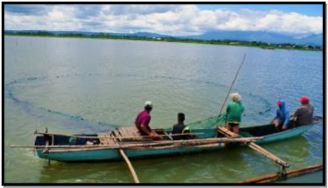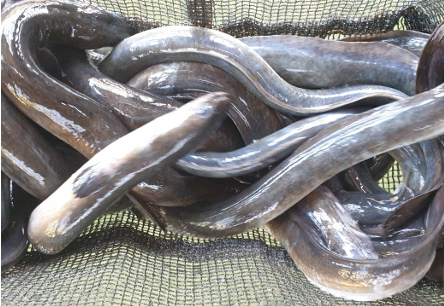
Project 1. Mark-Recapture Strategy to Estimate Population Size and Track Site Fidelity of Invasive Knifefish in Laguna de Bay
In order to come up with strategies for control and management of the invasive knifefish, information on its population density, abundance and migration patterns was conducted. This was done using capture-mark-recapture surveys using tags at different sampling points representing the East, Central and West Bays. Additionally, assessment of different fishing gears that were being used to collect knifefish was conducted.
Movement displacement was observed in recaptured knifefish, location of recaptures suggests that knifefish, once tagged, move towards shallower areas toward Northeast. No migration between Bays were observed. The limited migration range of knifefish may be attributed to obstructions in the lake such as fishpen and cages or other human activities like fishing. Beach seine (seket) had the highest number of knifefish caught. However, it catches smaller fishes like ayungin and tilapia fingerlings which can be considered destructive. Longline was the most preferred fishing gear used in collecting knifefish. Knifefish catch was higher near fish cages or fishpens than in open waters.
Based on the results of this study, continuous high fishing pressure for knifefish is recommended to keep their population under control. Fishing efforts should be increased in locations with high densities like the East and West Bays. The government should provide subsidies and assistance to fishermen and influence the demand for this fish.
Knifefish was found to aggregate near fish cages or fish pens. Anchoring structures such as bamboo poles or anahaw were preferred to be breeding nests for knifefish. Stricter implementation of zoning and limits in placing fish pens and cages is necessary to reduce potential breeding grounds for the knifefish. Abandoned fish cages and pens should be cleaned up by their consequent owners and a fine should be imposed when this is neglected.
Project 2. Distribution, Habitat Characterization and Control Strategies for Juvenile Knifefish in Laguna de Bay
A total of 18 sampling stations belonging to the seven sampling sites were surveyed from July 2018 to May 2019. Collection of juvenile knifefish at shallow waters was performed via push net or seine net while cast net or gill net was used in deeper waters. Among the 431 individuals collected, 300 were caught in Los Baños, Laguna (69.61%), 80 (18.56%) in Talim Island, and 46 in Jalajala, Rizal (10.67%). Also, juvenile knifefish catch was observed to increase from July to September 2018 and decrease thereafter until May 2019 given the seasonality of spawning of this species. Moreover, factors which are also possibly associated with the occurrence of juvenile knifefish (e.g. prey abundance, submerged macrophyte cover, water turbidity and depth) aside from the physico-chemical parameters are needed to be examined further.
For year 2 (July 2019-January 2020), a total of 42 juvenile knifefish individuals were sampled, majority of which were collected in Los Baños, Laguna (23 individuals, 54.76%) and lowest in Pila, Laguna (one juvenile knifefish, 2.38%). In addition, a decreasing trend was observed throughout the sampling period. In general, dissolved oxygen was determined to be the water quality parameter that did not meet the allowable limit set which corroborates with GAM et al. (2017) that C. ornata has high tolerance for extreme environmental conditions. Using Canonical correspondence analysis (CCA), juvenile knifefish were observed to have positive correlation with varying range of physico-chemical parameters for Years 1 and 2 which is a characteristic of an invasive species.
In terms of specificity, fishes caught using cast nets were dominated by one species. Push net and seine net on the other hand have the highest diversity of species caught and highest probability of catching different species from a population. Hence, both push net and seine net are recommended for collecting juvenile knifefish in shallow waters while cast net is for deep waters.


